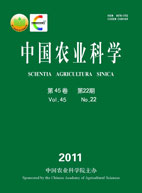-
Change of Maize Growth Period and Its Impact Factor in China
- DI Zhi-Fen, HU Wei, YAN Chang-Rong, LIU Qin, LIU Shuang
-
Scientia Agricultura Sinica. 2012, 45(22):
4587-4603.
doi:10.3864/j.issn.0578-1752.2012.22.005
-
 Abstract
(
819 )
Abstract
(
819 )
 PDF (3296KB)
(
1370
)
PDF (3296KB)
(
1370
)
 Save
Save
-
References |
Related Articles |
Metrics
【Objective】 In the background of global climate change, the sowing time, maturity time and growth period of maize, and the changes of climate resource in China were analyzed.【Method】After collection of maize growth period data of 2414 counties and meteorological data of 618 meteorological stations from 1971 to 2010, by using the Kriging method, the distribution of maize sowing time and maturity time of 1970s and 2000s were drawn, and the annual temperature, precipitation and solar radiation were calculated in those two periods. Taking the crops area as the basic unit, the regression equation between agro-climatic resources and the change of maize sowing time and maturity time were built in different areas. Put B2 scenario data from PRECIS model into the equations, the maize growth period were predicted in 2030s. 【Result】 Compared with 1970s, the sowing time in 2000s was unchanged in Northeast soybean, spring wheat and beet area; while in other agricultural planting areas were advanced about 1 to 15 days. And the maturity time was delayed 11 days and 3 days in Northeast soybean, spring wheat, beet area and Northern plateau small grains, beet area, while other areas advanced 3 to 12 days. The maize growth period shortened about five days in Yunnan-Guizhou Plateau rice, corn, tobacco area, which remained unchanged in cotton, wheat, oil, tobacco, fruit area, South double cropping of rice, tropical crops, sugarcane area and Northwest Oasis wheat, cotton, beet, grape area, while in other regions has extended longer. In 2030s of B2 scenarios, the maize sowing time will delay 2 to 5 days in Northeast soybean, spring wheat, beet area, while in other agricultural planting areas may be advanced 2 to 19 days comparing to 2000s. The maturity time will delay 4-15d in Northeast soybean, spring wheat, beet area, Northern plateau small grains, beet area and South double cropping of rice, tropical crops, sugarcane area, which will advance 2 to 12 days in cotton, wheat, oil, tobacco, fruit area,Yangtze River rice, cotton, oil, mulberry, tea area,Sichuan and Shaanxi Basin rice, corn, potato, citrus, mulberry area and Yunnan-Guizhou Plateau rice, corn, tobacco area, and it will essentially unchanged in South Hills double cropping of rice, tea, citrus area and Northwest Oasis wheat, cotton, beet, grape area. Comparing to 2000s, the maize growing period in 2030s will reduce 3 to 6 days in cotton, wheat, oil, tobacco, fruit area and Yunnan-Guizhou Plateau rice, corn, tobacco area, and in other regions it will extend 2 to 15 days. 【Conclusion】The climate is changing to warming, dry and low radiation. By impact of temperature, precipitation and solar radiation, there exists an objective change of maize growth stage in different agricultural planting areas, and the sowing time will advance in most part of China, the maturity time will become more complex, and the growing period of maize will extend in most part of China.









